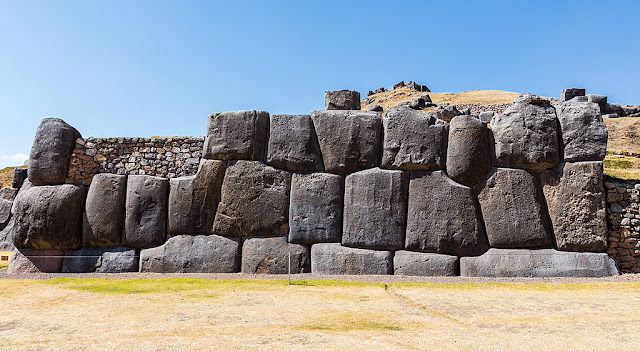-----------ooOoo-----------
We tend to think of the past, the ancient past rather than the recent centuries, and the ancient civilizations, as primitive and unsophisticated, but think again – Bored Panda recently featured a variety of photographs of artifacts and relics that showcase the ingenuity of ancient societies.
Click on the following to view:
The BP pics come from two sites:
‘Ancient Civilizations’ at:
and
‘This is Ancient’ at:
Here is a selection with the BP headings, my comments added . . .
-----------ooOoo-----------
10,000-Year-Old Dabous Giraffes In Niger:
The Dabous Giraffes are neolithic petroglyphs (an image created by removing part of a rock surface by incising, picking, carving, or abrading, as a form of rock art). Located in Niger in West Africa, the artists are unknown. The carvings are 6 metres (20 ft) in height and consist of two giraffes, one male and the smaller female. They are the largest known animal petroglyphs in the world.
In the surroundings, 828 images have been found engraved on the rocks, of which 704 are animals (cattle, giraffes, ostriches, antelopes, lions, rhinoceros, and camels), 61 are human, and 17 are inscriptions in Tifinâgh. The carvings are believed to have been done between 6,000 and 8,000 years ago (not 10,000 years as the heading states), during the African humid period, when the region was less arid, and the Sahara was a vast savannah. The earliest of the Dabous carvings may date back as far as 10,000 years, however the giraffes are believed to be newer due to the lack of erosion.
__________
A Bird Looking At Statue Of Griffin (Persepolis):
Persepolis in modern day Iran was the ceremonial capital of the Persian Empire (c. 550–330 BC).
After invading Persia in 330 BC, Alexander the Great sent the main force of his army to Persepolis. On his way to the city, Alexander and his army were met by 800 Greek artisans who had been captured by the Persians. Most were elderly and suffered some form of mutilation, such as a missing hand or foot. They explained to Alexander the Persians wanted to take advantage of their skills in the city but handicapped them so they could not easily escape. Alexander and his staff were disturbed by the story and provided the artisans with clothing and provisions before continuing on to Persepolis. It is possible Alexander started to see the city in a negative light after this encounter.
The city was destroyed by fire which from the living quarters of Xerxes I, and spread to the rest of the city. It is not clear if the fire was an accident or a deliberate act of revenge for the burning of the Acropolis of Athens during the second Persian invasion of Greece.
The above griffin photograph is only part of the sculpture, which sits on top of a column. It is the only one which has been found in the ruins. The full sculpture:
The bird in the first griffin pic may be building a nest in the griffin’s beeak.
BTW:
A griffin is a legendary creature with the body, tail, and back legs of a lion, and the head and wings of an eagle with its talons on the front legs.
__________
Gold Scythian Pectoral, Or Neckpiece, From A Royal Kurgan In Tolstaya Mogila, Pokrov, Ukraine, Dated To The Second Half Of The 4th Century BC
The Golden Pectoral from Tovsta Mohyla is a gold Scythian collar or pectoral discovered in the Ukraine in 1971. It is now in the Museum of Historical Treasures of Ukraine in Kyiv. It probably dates from the 4th century BC, and was made by Greek goldsmiths, probably a workshop based in Scythian lands.
The pectoral is made of solid 24 carat gold, with a diameter of 12 inches (30.6 cm) and weighs just over 2.5 pounds (1150 g). It is in the shape of a crescent and can be stylistically broken down into three sections:
- The top section reflects Scythian daily life.
- The middle section is believed to represent Scythian connection to nature. Being that there are so many delicate details in this section the artisan(s) chose to solder all of the individual elements to a solid gold plate which serves as a backing for structural support.
- The third section is thought to represent Scythian belief in the cosmos and their mythology.
It is believed that the pectoral was created by soldering together dozens of individually cast figures and elements.
Some details:
__________
Egyptian Faience Beaded Fishnet Dress Dating From The Fourth Dynasty, C. 2550 BCE
This beadnet dress is the earliest surviving example of such a garment. It has been painstakingly reassembled from approximately seven thousand beads found in an undisturbed burial of a female contemporary of King Khufu.
Although their string had disintegrated, a few beads still lay in their original pattern on and around the mummy, permitting an accurate reconstruction. The color of the beads has faded, but the beadnet was originally blue and blue green in imitation of lapis lazuli and turquoise.
__________
125 Ton Stone Perfectly Placed At Sacsayhuaman Peru — An Incredible Feat Of Megalithic Masonry
Sacsayhuamán is a citadel on the northern outskirts of the city of Cusco, Peru, the historic capital of the Inca Empire. The complex was built by the Incas in the 15th century, with dry stone walls constructed of huge stones built on the site, the workers carefully cutting the boulders to fit them together tightly.
A section of the wall of Sacsayhuamán
Sideways view of the walls of Sacsayhuamán showing the details of the stonework and the angle of the walls.
The Inca were incredibly skilled at stonework. It was a part of their normal culture to quarry and shape enormous rocks, and to move them with a system of ropes, logs and levers. They used smaller stones and sand to finish the worked stone to achieve the final look.
__________
Roman Mosaic Depicting The Trojan War Found In Syria Two Years Ago
More than a thousand years old, the massive mosaic, which depicts the Trojan War and mythological figures, spans roughly 120 square metres (1,300 square feet). The mosaic, which was found in Rastan, shows scenes from the Trojan War, Amazon warriors, and the Roman sea god Neptune alongside 40 of his mistresses. The ancient artwork could be part of a bathhouse, but archaeologists are still uncertain.
__________
Cross Section Of A Road In England (A303 Road)
The illustration depicts the development of the road through the ages.

















No comments:
Post a Comment
Note: Only a member of this blog may post a comment.